Lawn Renovation
Lawn Renovation
Help Your Lawn Reach Its Potential
Once we determine your lawn’s problems, we create the ideal solutions and treatment for lawn renovation to restore your lawn to its full potential. Extensive thatch accumulation can deteriorate your lawn’s health and appearance. Proper preventive maintenance, such as thatching or aeration along with over seeding, can enhance lawn growth and allow root development for a healthy turf. We provide lawn renovation solutions in NJ including soil preparation, aeration, seeding or sod installation, and more. Let us help you get your lawn to look its best.

Why Aerate the Lawn
Aeration can be extremely important to ensure a healthy lawn and it’s part of lawn renovation because it alleviates soil compaction or excess thatch and allows oxygen, water, and nutrients to penetrate the roots.
The most common reason for aerating is to reduce soil compaction which prevents the proper circulation of air, water and nutrients in the soil. If there is excess thatch, roots can be starved of these necessary elements
Aerating will aid in deeper growing roots and allow for a stronger grass that will grow thicker and greener on the surface. Grasses with deep root growth are far more drought tolerant so less watering will be required.
Signs the Lawn Needs to be Aerated
Aeration is extremely important if the lawn:
- Was created for a newly constructed home and on subsoil
- Was created with sod and soil layering has become the problem.
- Gets a lot of traffic and use contributing to soil compaction
- Dries out easily or feels spongy due to excessive thatch
- Has a layer of thatch that is thicker than half an inch
- Has areas where the lawn stops growing or is more sparse
- Always has puddles after a rain or water just seems to run off
Best Time to Aerate the Lawn
When to aerate the lawn depends upon the type of grass you have and when it begins the period of most active growth.
Cool season grasses such as fine fescues, ryegrasses, and Kentucky Bluegrasses should be aerated in early fall or early spring. Warm season grasses such as Zoysia and Bermuda Grass should be aerated in the late spring.
Aerating should be done prior to fertilizing or reseeding and when the soil is moist, never during a period of drought or extreme heat.

Seeding
Timing is important when it comes to lawn seeding. The most ideal conditions for turf grass establishment are during the late summer and early fall season. Cooler temperatures help to keep seed from drying out, yet offer enough rain to help them germinate.
Cool evenings and moderate daytime temperatures, along with anticipated seasonal precipitation are great for rapid grass seed germination.
Seeding during the fall gives the grass adequate growth time prior to the winter. There is less competition for weeds, such as crabgrass that tend to die off during this time.
Soil Preparation is Critical for Success
The condition of your soil should be at its best for germination. Before seeding or sodding it’s important to amend poor soils, such as heavy clay, by adding organic matter. This includes compost material and quality topsoil.
Organic matter contains micro-organisms that work together with the roots of plants to absorb the nutrients in the soil. These materials should be tilled into the existing soil rather than spread on the surface. The goal is to have 5 to 6 inches or more of well-prepared soil.
Soil preparation should be performed when the soil is not too dry or wet as rototilling can destroy soil structure. It can also create problems with air and water holding capacity and drainage after a rain event
Another important key to soil preparation is rough grading. It’s important to establish a favorable final grade. Rough grading should include the removal of any rock or other debris that would obstruct the growth of new turf.
Always avoid burying branches, wood, and construction debris, as this could cause problems for the grass later. Eliminate any dip and large depressions or raised areas. Final slopes should be pitched away from buildings.
Expect to keep the soil moist for about 15-20 days. This allows for germination and for the seedlings to become established. Keep kids and pets off the seeded areas. Once the grass is established you can begin mowing after the grass reaches about three to four inches in height. Seeding plays a vital role in lawn renovation.
How to Care for Your Newly Seeded Lawn
- Clay soils can be too hard for roots to penetrate and become established.
- Clay soil tends to be alkaline, which makes iron less available to plants.
- It compacts easily, reducing the amount of oxygen to the roots of the plant.
- Clay traps water for long periods of time periods.
- Clay soil causes pooling and drainage problems.
- It becomes rock hard when dried.
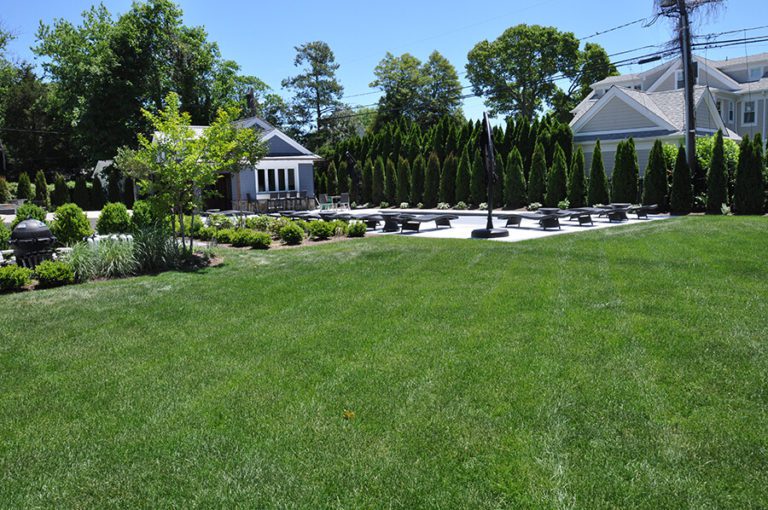
Sod Installation
If you’re looking for a ready-made lawn with less maintenance, we can do the entire sod installation in NJ, including old lawn removal, leveling, soil preparation, and laying sod.
The advantages of sod installation it includes less irrigation once established, no waiting for grass to grow in, and it’s ready for use much more quickly. Much less mud and dirt will be tracked into the house.
When to Lay Sod
Sod can be laid any time during the growing season and can accept heavy rainfall without erosion or damage. Sod can even be installed in the winter, but the most ideal times in some areas are early fall and spring. Proper soil preparation providing the right amount of moisture is most important in getting sod to properly take root. This takes approximately two to three weeks.
Sodded lawns are perfect on slopes and eliminate mud problems while the grass is becoming established.
What to Expect with a New Sod Installation
Prior to Sod installation, your soil will have to be properly prepared and in many cases improved. Your soil may contain too much clay, too much sand or the wrong pH. If your home is new construction, the better topsoil has probably been turned under leaving subsoil on top.
The entire area may need to be rough graded and all debris, buried stumps, and rocks need to be cleared. Drainage needs to be considered and the soil should be tilled to the proper depth. The soil may then need to be amended and topsoil may need to be added along with a starter fertilizer. The entire area will need to be rolled with a lawn roller before sod is installed. Contact us and get the best sod installation service from our lawn renovation professionals.
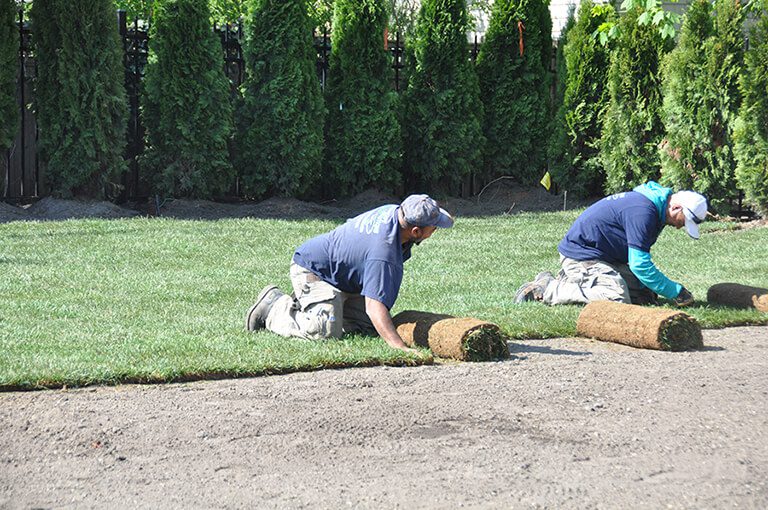
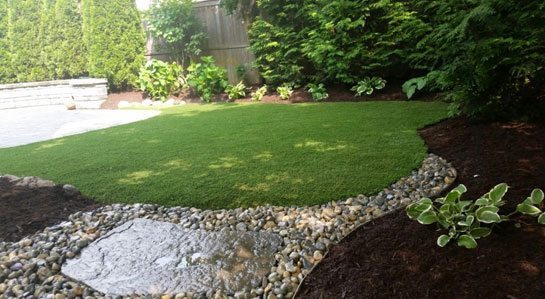
Artificial Turf
Artificial Synthetic grass, once installed, requires little maintenance, is long lasting, and offers excellent drainage. Synthetic turf always maintains a perfectly manicured appearance.
- No watering.
- No lawn mowing.
- No more expensive fertilizers and weed killers.
- No more weeds.
- Good drainage also means no puddling and no mud.
- Playing sports on synthetic turf will not damage the grass.
- Pets stay clean.
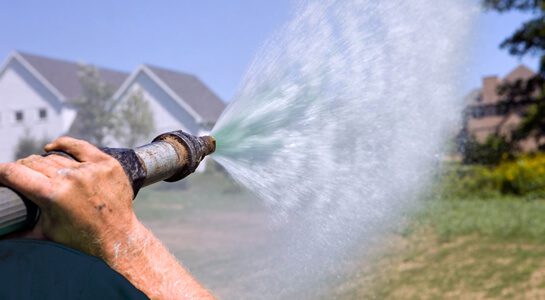
Hydroseeding
Hydroseeding is a very quick and cost-effective way to grow a new lawn.
A special blend of high quality turf mix, water, and a protective growth medium is sprayed on your property. The mulch offers moisture retention, erosion protection, and insulation. Eventually it breaks down and becomes part of the soil.
The germination time for hydroseeding depends on a number of factors, but usually grass will be visible in 5-7 days.
Properly prepared ground and the correct mix for your property, ensures a new lawn that is as thick and lush.
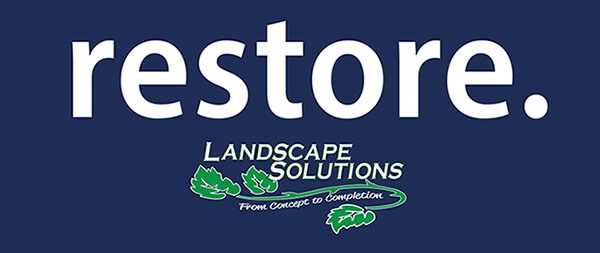
Contact Landscape Solutions Today
Arrange for a landscape design consultant to meet with you and take that first step to increasing the value of your home and the enjoyment of your property.
Tell Us How We Did
Our Customer Reviews




